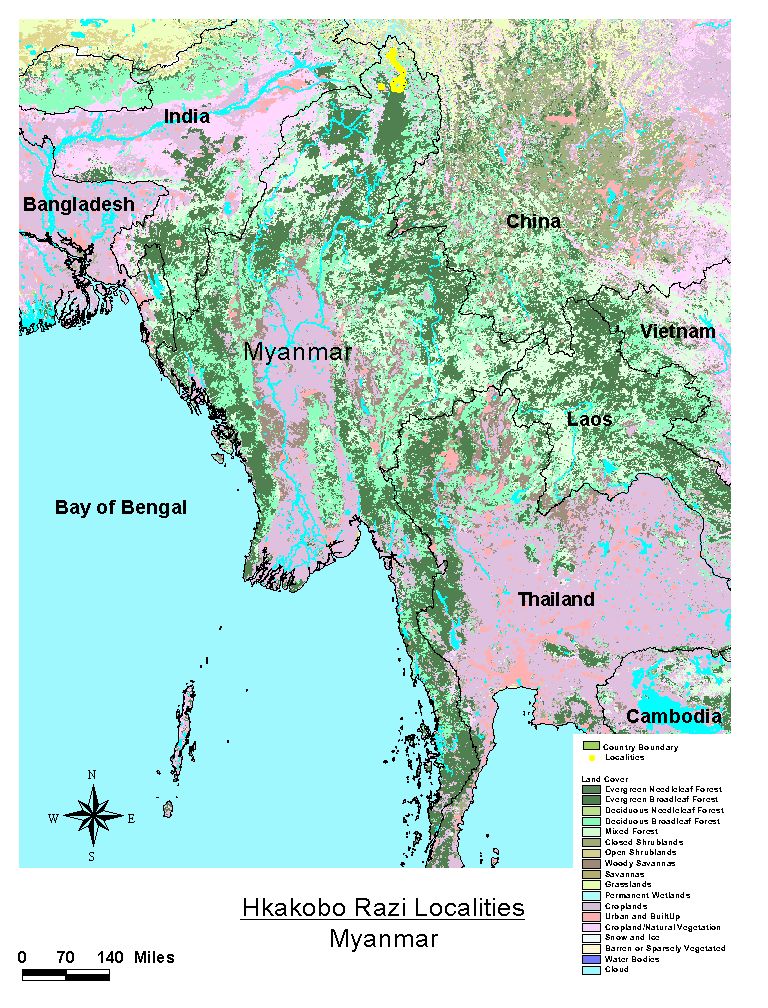Urgency and Conservation
Major Threats to the Amphibians and
Reptiles of Myanmar
Habitat Loss-Although Myanmar has the greatest amount of pristine habitat in southeast Asia, it faces persistent habitat destruction and fragmentation mainly due to heavy logging.
 |
| Courtesy of Conservation and Research Center, Smithsonian Institute |
Most low-lying areas of Myanmar have supported large human populations and have been intensely farmed since the eleventh century (Phayre 1883). Population growth and environmental exploitation have increased dramatically since the mid-1800s and nearly exponentially so since the 1960s.
In that respect, Myanmar has few pristine habitats; however, relative to surrounding nations, environmental exploitation has proceeded at a slower rate. For example, in the early 1980s, satellite imagery, studied as part of the FAO-assisted National Forest Management and Inventory Project, showed the amount of intact forest in Myanmar to be 276,250 sq. km or 42 % of the total area in 1979-1981.
A more recent national report (Shwe Kyaw 1988) to FAO suggested a reduction of forest cover to 36% by 1988. Brunner (1998) has documented a more recent and dramatic increase in logging in the northern Kachin State, where much of Myanmar's remaining forest occurs.
This map (at left) based on satellite imagery depicts evergreen and deciduous forests in shades of green, shrublands and grasslands in shades of brown and croplands and urbanized areas in shades of pink and purple.
In addition to the legal logging, there is a recent upswing in illegal logging by Thai companies on the eastern border (triggered by Thailand's recent ban on logging (Hill 1994)) and by the Chinese in northeastern Kachin State along the western slope of the Gaoligon Mountains (Vindum per. obser. 2002). Although the 1,320 km border with India has poor transport infrastructure, making large-scale logging difficult, there are published reports (ITTO, 1996) of increased timber exports to India. An illegal timber trade is already flourishing between Manipur State, India and Sagaing Division and Kachin State, Myanmar.
Our field work has revealed that a large portion of the forests in forest reserves are being selectively logged, and charcoal-makers rapidly follow to complete the job of decimation. Charcoal production prevents forest regeneration by encouraging its replacement by bamboo thicket or weedy grasslands. The remaining forests in Myanmar are now considerably less than that 36% estimate of a decade ago. The urgency noted by Dinerstein and Wikramanayake (1993) concerning the amount of existing forest and the lack of protected areas in Myanmar is even greater now than when they warned of the loss of species through continuing forest degradation and loss.
Illegal Trade of Animals-Many species of reptiles and amphibians face increased threat due to illegal animal trade with China. There is an enormous illegal trade in snakes in the central dry zone that is centered in the Mandalay, Magwe and Sagaing Divisions. The species exploited are primarily: Russell's viper (Daboia russelii), rat snake (Ptyas mucosus), and copperbelly racer (Elaphe radiata), as well as cobras (Naja kaouthia and N. mandalayensis). The snakes are captured by collectors who sell them at distribution points. From there, the snakes are sold to Chinese merchants. Many distribution points exist; we estimate there are 30 throughout the dry zone. Each week, the snakes are picked up and driven to China where they can be purchased for food or "medicine". We estimate that 1.6 million pounds of snakes are being exported each year (Slowinski unpublished data 1999).
Turtles are also suffering alarming exploitation. In five years of surveys, we have encountered only 9 terrestrial and freshwater turtle species in Myanmar, out of 29 known from the literature. More data on the trade of turtles is needed. Chinese markets are the primary harvesters of Asian turtles as have been documented by the New York Turtle and Tortoise Society.
Conservation Efforts
The Southeast Asian Global Amphibian Assessment, hosted by IUCN and DAPTF, was attended by project representative Guin Wogan. The addition of data for Myanmar species helped determine the population status and major threats to amphibian species in southeast Asia. This is the first time new data from Myanmar has been available for most species since before the Second World War.
Weekly market surveys are now being carried out in two regions of Myanmar in the hopes that these surveys will help determine the extent of trade and usage of animals. Many species of reptiles and amphibians are used within Myanmar for food and folk medicine. Amphibian species, such as Glyphoglossus molossus, Rana tigerina and Rana rugulosa, are sold for use in curry, and the only known salamander in Myanmar, Tylototriton verrucosus, can be found dried, packaged, and for sale as remedies for "childhood diseases."
Recently, members of the Myanmar Herpetological Survey Project field team have assisted law enforcement officials in identifying rare and endangered reptile species being sold illegally in Chinese restaurants in Yangon. Although just a small start, jail sentences and heavy fines imposed on the restaurant owners may help discourage the illegal trade in animals throughout Myanmar.